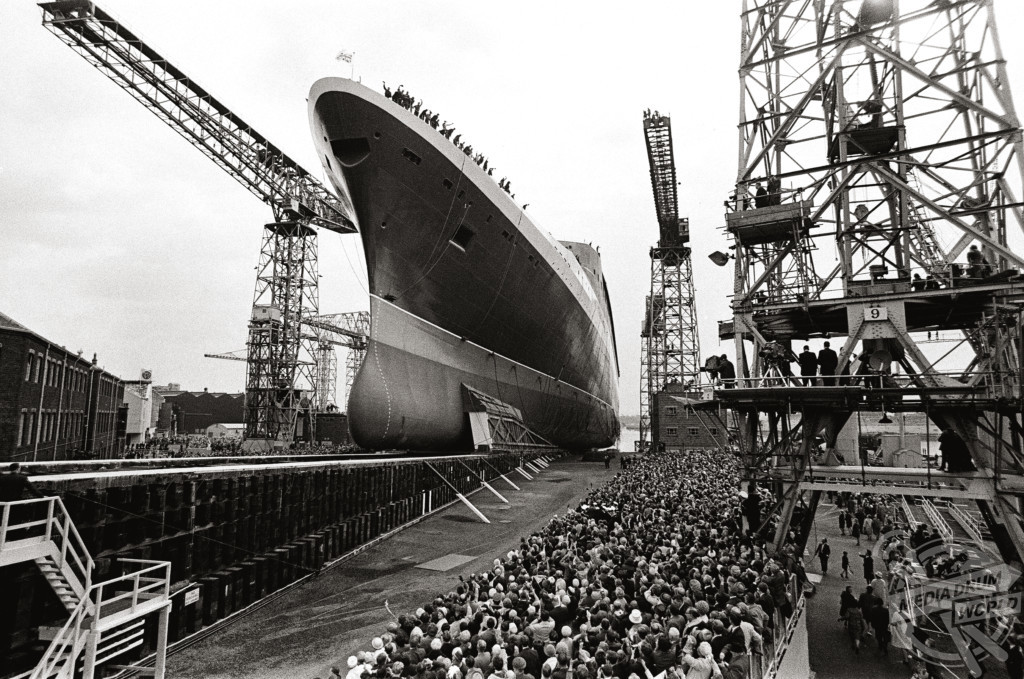
By Alex Jones
BRITAIN’S remarkable industrial heritage is celebrated in a glorious new photobook which captures how much the country’s industry has changed over the last century – with most of the UK’s crowning achievements completed before the UK even considered joining the EU.
Stunning shots from across the last century show exacting wartime workers standing next to rank after rank of Hawker Typhoon fighter planes in production in 1944, a diligent if not slightly flustered woman surrounded by stacks of music records at the height of Beatlemania, and the unmistakable shape of a Concorde taking flight above the British countryside in 1970.

Other incredible images show a huge ship looming over children playing in the street in the North East and steelworkers stoically working under a shower of sparks.
The inspiring collection is included in Patrick Potter’s Made in Britain: A Photographic History of Britain at Work, a fascinating insight into where the UK’s manufacturing came from and where it is going.
“This is a book about work, in Britain in the 20th Century,” explained Potter.
“Work was pretty simple at the beginning of the 20th Century – you make useful stuff or you provide a useful service and then you sell it at a profit.

“Most people didn’t have money, the people who did have money used it make more money by employing the people who didn’t have any money for subsistence wages.
“Workers did not aspire as individuals, they survived as communities and struggled for a better deal as trade unions.”
The captivating photobook looks at all aspects of Britain’s industrial heritage over the last hundred years – exploring the steelworks, car factories, mines, shipyards and workshops which kept the country among the most influential nations on Earth.
Potter also examines the rising power of individuals throughout the century, whether workers fighting for their rights in the political leaders who clashed with the unions, sparking grand strikes.

The book is set out by the decade so the pace of change is shockingly apparent – the stark move from physical labour to a digital age.
“By the end of the 20th Century the mysteries of world trade, high finance, insurance, credit, rent, globalisation and oil wars seemed so difficult to understand that we all sort of gave up trying and let computers get on with it,” added Potter.
“There was nothing simple about work anymore and people were generally convinced that the needs of a mysterious magical beast called ‘the economy’ must be served by all people of all classes at all times.
“In Britain, more people had more money than ever before, but everybody was now depressed.
“Jobs had weird titles and seemed to revolve entirely around phone calls and emails.
“Nobody was really sure what work was anymore.

“Everybody was a barista or a phone shop adviser, customer service representative or social media influencer.
“Freelancing became a thing. Somehow having a laptop open in a café became considered work.”
However, Potter is of the impression that the UK should ‘look back to leap forward’ and believes employees should continue evaluating and challenging their role within the workplace.
He also suggests that it may be time to reconsider some long held ‘home truths’ as technology advanced day-by-day and the population continues to soar.
“The old type of work has not entirely gone away, some of it went abroad, some of it went to the most isolated communities of immigrants, most of it went to computers and robots and some of it went to slaves,” he continued.
“Work in Britain was changed and it continues to change at an intense pace.

Bela Zola, Daily Mirror. Mediadrumimages/Mirrorpix/PatrickPotter
“The one thing that has remained consistent throughout all this change in British culture is the general belief that Hard Work is a Virtue.
“We snigger at the French with their thirty-hour week. We laugh openly at Scandinavian men taking months of paternity leave. We suck our teeth in knowing disapproval when ‘lazy’ Mediterranean economies collapse.
“Most of all we are horrified at the lack of work ethic in ‘the young’.
“We call our children ‘millennials’ as if they are another immigrant group from the lazy land of Millenia.
“Yet any armchair economist will tell you that our problem today is overproduction.

“We make far more stuff than we need. We have a system that depends on infinite growth while we live on a planet of finite resources.
“If anything, we need to work less, to slow down – to start to imagine an economy where anything that can be done by robots will be.
“How is that labour saving technology has not liberated us all from the forty-hour week?
“Unemployment is never going to go away.”
Patrick Potter’s Made in Britain: A Photographic History of Britain at Work, published by Carpet Bombing Culture, is released on 28 March. Please pre-order here.




